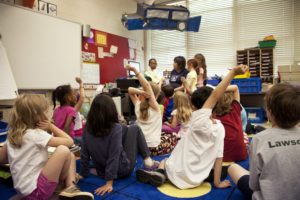As stated in the “Social Interactions in K-12 Learning” Chapter of The Handbook of research on K-12 online and blended learning by Garret Dikkers, “affective association (how students and teachers show emotion online), community cohesion (seeing the class as a community), instructor involvement (how the teacher shows involvement in student learning), interaction intensity (what ways and how often students interact), knowledge and experience (ways students share their prior knowledge and experiences with course content)” are the five aspects that guide meaning making in an open and online setting (p.513). Instructor involvement is stressed as the most important aspect that guides “meaning-making” (p. 512). As a student myself I have found this to be true.  When I can have a connection with a teacher, feel comfortable asking questions, and feel understood and heard I am much more willing to take risks in my learning and to reach out for help. Having a teacher that is intimately involved with the learning that takes place transforms a learning experience, especially in an online setting. Providing opportunities for “connection to others in a learning space can contribute to satisfaction, enjoyment, and greater learning” (Garret Dikkers, 2018, p. 512). Collaborative experience help to stimulate learner-learner interactions and learner-instructor interactions, which help to create a sense of community when online.
When I can have a connection with a teacher, feel comfortable asking questions, and feel understood and heard I am much more willing to take risks in my learning and to reach out for help. Having a teacher that is intimately involved with the learning that takes place transforms a learning experience, especially in an online setting. Providing opportunities for “connection to others in a learning space can contribute to satisfaction, enjoyment, and greater learning” (Garret Dikkers, 2018, p. 512). Collaborative experience help to stimulate learner-learner interactions and learner-instructor interactions, which help to create a sense of community when online.
Both Constructivism and Social Development Theory stress the importance of social interaction in learning and the benefits of collaboration (Garret Dikker, 2018, p.509). By creating discussion boards, web conferences, encouraging social networking, and providing curated, purposeful lessons, educators help to build relationships in an online setting (Garret Dikker, 2018, p. 515). It is important to note, in all of these examples, the “importance of mitigating risk, psychological safely, appropriate teacher-student interaction and protection of privacy” should always be considered (Garret Dikker, 2018, p. 516).
By creating discussion boards, web conferences, encouraging social networking, and providing curated, purposeful lessons, educators help to build relationships in an online setting (Garret Dikker, 2018, p. 515). It is important to note, in all of these examples, the “importance of mitigating risk, psychological safely, appropriate teacher-student interaction and protection of privacy” should always be considered (Garret Dikker, 2018, p. 516).
As an educator selecting the mediums that fit your pedagogy, staying within the FIPPA guidelines, and the acceptable use policy of your school are things that are of great importance. Online schooling does not have to mean a loss of student-teacher relationships or peer relationships. Pedagogy has to be adapted and be more purposeful to ensure that this integral part of meaning-making is not lost.
Before the readings, I was in the mindset that online schooling, as the only mode of learning, would not be able to provide the same standard of education, but the readings this week proved that it is possible through a more purposeful curation of resources and tools. My one outstanding question is, how can these ideas be adapted to younger students who are too young to be on social networks and require more hands-on help and guidance when using online tools?
My one outstanding question is, how can these ideas be adapted to younger students who are too young to be on social networks and require more hands-on help and guidance when using online tools?
Citations
Garrett Dikkers, A. (2018) Social Interaction in K-12 Online Learning. In R. Ferdig & K. Kennedy (Eds.), Handbook of research on K-12 online and blended learning (pp. 509-522 ). Pittsburgh, PA: Carnegie Mellon University ETC Press.

alexamclean
Feedback for EDCI 339:
Your post did a good job highlighting the five ways that enhanced meaning-making which Garret Dikkers stated. I liked the addition of the video to help further define some of the terminologies in the chapter. I would have liked to hear more about the research findings that Garret Dikkers highlighted (what interaction was found to be the most valued). Also, in the beginning, the full name of the author is Amy Garret Dikkers, so perhaps include that when you first mention the author and then refer to them with their last name. I loved the personal anecdote that supported the article’s claims. Overall, a great post that could just use a few more details. Looking forward to reading your revised version in your e-portfolio.
hgus123
Your first blog post does an excellent job of summarizing the Dikkers article in great detail. I especially enjoyed how you integrated your own thoughts as a student and how forming those relationships allow you to take risks. One suggestion you may want to consider is how you could integrate the other reading from topic one into your blog post. I also liked how you defined the five aspects of the social presence model in the opening sentence, however, it is a bit long so maybe consider breaking it into two separate sentences. Also, check your APA citation for the second quote as it is missing the year and author! In your third paragraph, I appreciated the part where you mentioned the importance of FIPPA which we had learned about beyond the assigned readings. Overall, I thought it was very well written and make for a strong first blog post!
sarahbjelde
Hello Lauren! Wow, what a stunning summary of Garrett Dikkers’ article—it really emphasized the important parts of the piece while connecting it to your own experiences as a learner. I really appreciated the fact that you tied in Constructivism and the Social Development Theory into your post. It made the importance of considering risk, psychological safety, classroom interactions, and information protection while using online tools very apparent. Your final paragraph includes thoughts that are similar to my own on the topic of online schooling versus in-person instruction. I think this course #edci339 will help us gain confidence and EdTech/digital resources to add to our online teaching toolbelt. One thing that could help me appreciate your hard work on the blog, even more, would be bolding important parts of your paragraphs or creating subheadings as anchors to guide me through your post. Thank you for this clear and concise blog post that cemented my knowledge of this week’s readings and activities.